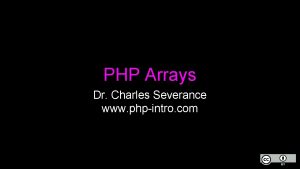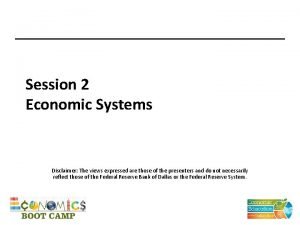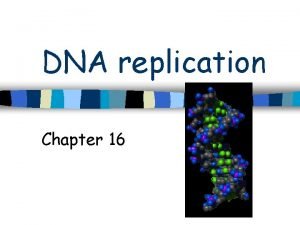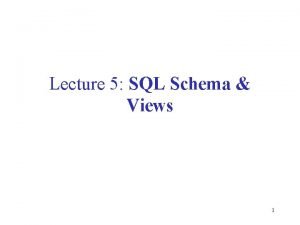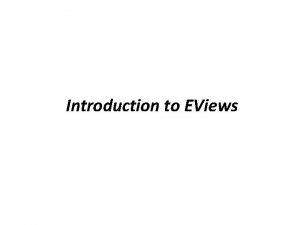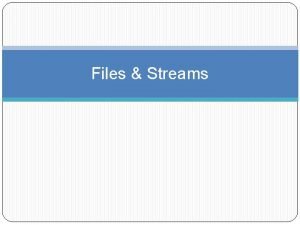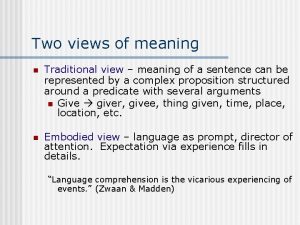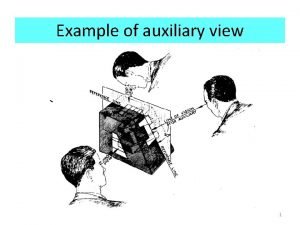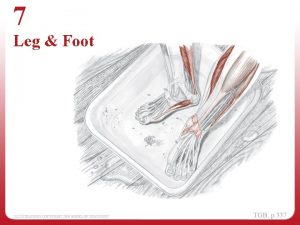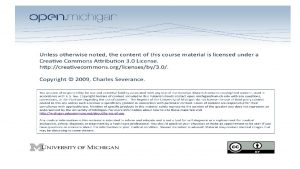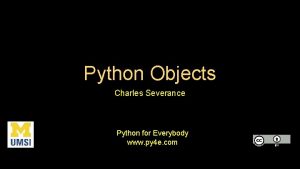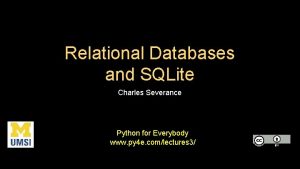Charles Severance www dj 4 e com Views

































































- Slides: 65

Charles Severance www. dj 4 e. com Views and Templates

Browser WGSIConfig Linux settings. py Django Click urls. py Routing views. py D O M Parse Response Templates Views forms. py Javascript N G I N X Shell /admin Database Models models. py admin. py

Views are the core of our application • Django looks at the incoming request URL and uses urls. py to select a view • The view from views. py • Handle any incoming data in the request and copy it to the database through the model • Retrieve data to put on the page from the database though the model • Produce the HTML that will become the response and return it to the browser https: //samples. dj 4 e. com/

Reading the URL • When Django receives an HTTP request it parses it, uses some of the URL for routing purposes and passes parts of the URL to your code Django Application (also folder) View within application https: //samples. dj 4 e. com/views/funky Key / value parameter (GET) https: //samples. dj 4 e. com/views/danger? guess=42 https: //samples. dj 4 e. com/views/rest/24 URL Path Parameter

URL Dispatcher A clean, elegant URL scheme is an important detail in a high-quality Web application. Django lets you design URLs however you want, with no framework limitations. To design URLs for an app, you create a Python module informally called a URLconf (URL configuration). This module is pure Python code and is a mapping between URL path expressions to Python functions (your views). This mapping can be as short or as long as needed. It can reference other mappings. And, because it’s pure Python code, it can be constructed dynamically. https: //docs. djangoproject. com/en/3. 0/topics/http/urls/

Three patterns for views (in urls. py) • Requests are routed to a pre-defined class from Django itself • Requests are routed to a function in views. py that takes the http request as a parameter and returns a response • Requests are routed to a class in views. py that has get() and post() methods that take the http request as a parameter and return a response

from django. urls import path from. import views from django. views. generic import Template. View # https: //docs. djangoproject. com/en/3. 0/topics/http/urls/ app_name='views' urlpatterns = [ # pre-defined class from Django path('', Template. View. as_view(template_name='views/main. html')), # function from views. py path('funky', views. funky), path('danger', views. danger), path('game', views. game), path('rest/<int: guess>', views. rest), path('bounce', views. bounce), # our class from views. py path('main', views. Main. View. as_view()), path('remain/<slug: guess>', views. Rest. Main. View. as_view()), [ views/urls. py

Viewing the Views

path('', Template. View. as_view(template_name='views/main. html')) views/urls. py views/templates/views/main. html <html><body><p>This is the views main. html sample</p> >p< >ul< <li>This page is coming from a file in views/templates/main. html</li> <li><a href="funky">Use a view function</a></li>. . . />ul< />p< <p>This sample code is available at <a href="https: //github. com/csev/dj 4 e-samples" target="_blank"> https: //github. com/csev/dj 4 e-samples</a> />p< </body></html>

Request and Response Objects Django uses request and response objects to pass information throughout your Django application. When a page is requested by a browser, Django creates an Http. Request object that contains metadata about the request. Then Django loads the appropriate view, passing the Http. Request as the first argument to the view function. Each view is responsible for returning an Http. Response object. The Application Programming Interfaces (APIs) for Http. Request and Http. Response objects, are defined in the django. http module. https: //docs. djangoproject. com/en/3. 0/ref/request-response/

class Http. Request Attributes All attributes should be considered read-only, unless stated otherwise. Http. Request. scheme A string representing the scheme of the request (http or https usually). Http. Request. body The raw HTTP request body as a bytestring. This is useful for processing data in different ways than conventional HTML forms: binary images, XML payload etc. For processing conventional form data, use Http. Request. POST. https: //docs. djangoproject. com/en/3. 0/ref/request-response/#django. http. Http. Request

class Http. Response In contrast to Http. Request objects, which are created automatically by Django, Http. Response objects are your responsibility. Each view you write is responsible for instantiating, populating, and returning an Http. Response. Passing strings Typical usage is to pass the contents of the page, as a string or bytestring, to the Http. Response constructor. https: //docs. djangoproject. com/en/3. 0/ref/request-response/#django. http. Http. Response

https: //samples. dj 4 e. com/views/funky path('funky', views. funky), from django. http import Http. Response. Redirect # Create your views here. def funky(request): response = """<html><body><p>This is the funky function sample</p> <p>This sample code is available at <a href="https: //github. com/csev/dj 4 e-samples"> https: //github. com/csev/dj 4 e-samples</a></p> /> body></html"""< return Http. Response(response)

https: //samples. dj 4 e. com/views/danger? guess=42 path('danger', views. danger), from django. http import Http. Response. Redirect # Create your views here. def danger(request) : response = """<html><body> <p>Your guess was """+request. GET['guess']+"""</p> /> body></html"""< return Http. Response(response) views/urls. py views/views. py

Danger – What Danger? I use the django. http. escape() function whenever I sense danger…

Why is that view named danger? • It is dangerous to take data from the user and include it in the HTTP Response without "escaping" the output. • HTML + Java. Script is a programming language and you don't want your users "sending code" to other user's browsers • Cross-Site Scripting (XSS) • https: //en. wikipedia. org/wiki/Cross-site_scripting • https: //en. wikipedia. org/wiki/List_of_XML_and_HTML_character_entity_references

https: //samples. dj 4 e. com/views/danger? guess=%3 Cb%3 EBold%3 C%2 Fb%3 E def danger(request) : response = """<html><body> <p>Your guess was """+request. GET['guess']+"""</p> /> body></html"""< return Http. Response(response) Response Source <html><body> <p>Your guess was <b>Bold</b></p> />body></html<

https: //samples. dj 4 e. com/views/danger? guess=%3 Cscript%3 Ealert%28%27 Owned%27%29%3 B%3 C%2 Fscript%3 E Response Source <html><body> <p>Your guess was <script>alert('Owned'); </script></p> />body></html<

https: //samples. dj 4 e. com/views/game? guess=%3 Cb%3 EBold%3 C%2 Fb%3 E from django. utils. html import escape def game(request) : response = """<html><body> <p>Your guess was """+escape(request. GET['guess'])+"""</p> /> body></html"""< return Http. Response(response) <html><body> <p>Your guess was < b> Bold< /b> </p> /> body></html< HTML entities

Parsing the URL after the Application and View https: //samples. dj 4 e. com/views/rest/41 urlpatterns = [ path('rest/<int: guess>', views. rest), [ <type: parameter-name> from django. http import Http. Response from django. utils. html import escape def rest(request, guess) : response = """<html><body> <p>Your guess was """+escape(guess)+"""</p> /> body></html"""< return Http. Response(response)

path('main', views. Main. View. as_view()), Class Views – Inheritance from django. http import Http. Response from django. utils. html import escape from django. views import View class Main. View(View) : def get(self, request): response = """<html><body><p>Hello world Main. View in HTML</p> <p>This sample code is available at <a href="https: //github. com/csev/dj 4 e-samples"> https: //github. com/csev/dj 4 e-samples</a></p> /> body></html"""< return Http. Response(response) https: //www. py 4 e. com/lessons/Objects

Parameters to Class Views https: //samples. dj 4 e. com/views/remain/abc 123 -42 -xyzzy path('remain/<slug: guess>', views. Rest. Main. View. as_view()), from django. http import Http. Response from django. utils. html import escape from django. views import View class Rest. Main. View(View) : def get(self, request, guess): response = """<html><body< > p>Your guess was """+escape(guess)+"""</p< /> body></html"""< return Http. Response(response) https: //www. py 4 e. com/lessons/Objects

HTTP Status Codes • http: //www. dr-chuck. com/page 1. htm - 200 OK • http: //www. dj 4 e. com/nowhere. htm - 404 Not Found • 500 Server Error • http: //www. drchuck. com/ - 302 Found / Moved Also known as “redirect” https: //en. wikipedia. org/wiki/List_of_HTTP_status_codes

HTTP Location Header • You can send a "Redirect" response instead of a page response to communicate a "Location: " header to the browser • The location header includes a URL that the browser is supposed to forward itself to. • It was originally used for web sites that moved from one URL to another. http: //en. wikipedia. org/wiki/URL_redirectio n

Sending a Redirect from a View https: //samples. dj 4 e. com/views/bounce path('bounce', views. bounce) from django. http import Http. Response. Redirect # This is a command to the browser def bounce(request) : return Http. Response. Redirect('https: //www. dj 4 e. com/simple. htm') https: //docs. djangoproject. com/en/3. 0/ref/request-response/#django. http. Http. Response. Redirect


Templates to Organize HTML https: //github. com/csev/dj 4 e-samples/tree/master/tmpl

Browser WGSIConfig Linux settings. py Django Click urls. py Routing views. py D O M Parse Response Templates Views forms. py Javascript N G I N X Shell /admin Database Models models. py admin. py

Templates Being a web framework, Django needs a convenient way to generate HTML dynamically. The most common approach relies on templates. A template contains the static parts of the desired HTML output as well as some special syntax describing how dynamic content will be inserted. A Django project can be configured with one or several template engines (or even zero if you don’t use templates). Django ships built-in backends for its own template system, creatively called the Django template language (DTL), and for the popular alternative Jinja 2. A template is simply a text file. It can generate any text-based format (HTML, XML, CSV, etc. ). A template contains variables, which get replaced with values when the template is evaluated, and tags, which control the logic of the template. https: //docs. djangoproject. com/en/3. 0/topics/templates/

What is a Template? • Concatenation and escaping can get tiresome and lead to very obtuse looking view code. from django. http import Http. Response from django. utils. html import escape from django. views import View class Rest. Main. View(View) : def get(self, request, guess): response = """<html><body< > p>Your guess was """+escape(guess)+"""</p< /> body></html"""< return Http. Response(response) https: //samples. dj 4 e. com/views/rest/24

Template Render Process Render Data Template Render Engine Rendered Output

Template Render Process { 'dat' : 'Fun > Stuff' } >h 1>Hi!</h 1< >pre< }}dat{{ />pre< Render Engine >h 1>Hi!</h 1< >pre< Fun > Stuff />pre<

URL -> View -> Template https: //samples. dj 4 e. com/tmpl/game/200 path('game/<slug: guess>', views. Game. View. as_view()) from django. shortcuts import render from django. views import View class Game. View(View) : def get(self, request, guess) : x = {'guess' : int(guess{ ( return render(request, 'tmpl/cond. html', x)

https: //samples. dj 4 e. com/tmpl/game/200 dj 4 e-samples/tmpl/templates/tmpl/cond. html <html> <head> <title>A conditional template</title> />head< <body> <p>Your guess was {{ guess }}</p> {% if guess < 42 %} > p>Too low</p< {% elif guess > 42 %} > p>Too high</p< %} else{% > p>Just right</p< %} endif{% />body< />html< from django. views import View class Game. View(View) : def get(self, request, guess) : x = {'guess' : int(guess{ ( return render(request, 'tmpl/cond. html', x)

Where are Templates? • A Django project is made up of one or more applications in folders dj 4 e-samples$ ls LICENSE. md README. md autos bookmany bookone hello crispy db. sqlite 3 dj 4 e-samples favsql form forums getpost gview pics requirements. txt rest route scripts home manage. py many menu myarts session tmpl tracks users views

Templates in Folders • It is common to reuse the "name" of a template file in several applications • We use a technique called "namespace" so that each application can load its own templates without template name collision dj 4 e-samples$ ls */templates/*/detail. html favs/templates/favs/detail. html favsql/templates/favsql/detail. html forums/templates/forums/detail. html pics/templates/pics/detail. html dj 4 e-samples$ https: //en. wikipedia. org/wiki/Namespace https: //docs. djangoproject. com/en/3. 0/topics/http/urls/#url-namespaces

Templates in Name Spaces • For the namespace to work, we need to put templates in a path that includes the application name twice. Weird but necessary. dj 4 e-samples$ ls */templates/*/detail. html favs/templates/favs/detail. html favsql/templates/favsql/detail. html forums/templates/forums/detail. html pics/templates/pics/detail. html dj 4 e-samples$ https: //en. wikipedia. org/wiki/Namespace https: //docs. djangoproject. com/en/3. 0/topics/http/urls/#url-namespaces

Django template language (DTL) https: //docs. djangoproject. com/en/3. 0/ref/templates/language/

Template Tags / Code Substitution {{ zap }} {{ zap|safe }} Calling code {% url 'cat-detail' cat. id %} {% author. get_absolute_url %} Logic Blocks {% if zap > 100 %} {% endif %} {% block content %} {% endblock %}

https: //samples. dj 4 e. com/tmpl/simple from django. shortcuts import render def simple(request): return render(request, 'tmpl/simple. html') dj 4 e-samples/tmpl/templates/tmpl/simple. html <html> <head> <title>A simple page</title> />head< <body> <h 1>This is pretty simple</h 1> />body< />html<

https: //samples. dj 4 e. com/tmpl/guess def guess(request) : context = {'zap' : '42{ ' return render(request, 'tmpl/guess. html', context) dj 4 e-samples/tmpl/templates/tmpl/guess. html <html> <head> <title>A simple page</title> />head< <body> <p>Your guess was {{ zap }}</p> />body< />html<

https: //samples. dj 4 e. com/tmpl/special def special(request) : context = {'txt' : '<b>bold</b, '< ' zap' : '42{ ' return render(request, 'tmpl/special. html', context) dj 4 e-samples/tmpl/templates/tmpl/special. html >body< <p>Your guess was {{ zap }}</p> > p>Escaped {{ txt }}</p< > p>Escaped not! {{ txt|safe }}</p< />body<

https: //samples. dj 4 e. com/tmpl/loop def loop(request) : f = ['Apple', 'Orange', 'Banana', 'Lychee[' n = ['peanut', 'cashew[' x = {'fruits' : f, 'nuts' : n, 'zap' : '42' } return render(request, 'tmpl/loop. html', x) dj 4 e-samples/tmpl/templates/tmpl/loop. html >ul< %}for x in fruits{% >li>{{ x }}</li< %}endfor{% />ul< %}if nuts{% <p>Number of nuts: {{ nuts|length }}</p> %}else{% > p>No nuts. </p< %}endif{%

https: //samples. dj 4 e. com/tmpl/nested def nested(request) : x = {'outer' : { 'inner' : '42{ { ' return render(request, 'tmpl/nested. html', x) dj 4 e-samples/tmpl/templates/tmpl/nested. html <body> <p>Your guess was {{ outer. inner }}</p> />body<

https: //samples. dj 4 e. com/tmpl/game/200 path('game/<slug: guess>', views. Game. View. as_view()) class Game. View(View) : def get(self, request, guess) : x = {'guess' : int(guess{ ( return render(request, 'tmpl/cond. html', x) dj 4 e-samples/tmpl/templates/tmpl/cond. html <p>Your guess was {{ guess }}</p> {% if guess < 42 %} >p>Too low</p< {% elif guess > 42 %} >p>Too high</p< %}else{% >p>Just right</p< %}endif %}

Template Inheritance https: //docs. djangoproject. com/en/3. 0/ref/urlresolvers/

Review Python Object-Oriented Programming https: //www. py 4 e. com/lessons/Objects

Inheritance • When we make a new template - we can extend an existing template and then add our own little bit to make our new class • Another form of store and reuse • Don't Repeat Yourself (DRY) https: //en. wikipedia. org/wiki/Don%27 t_repeat_yourself

Template Inheritance Render Data Base Template Render Engine Rendered Output Template

Template Inheritance tmpl/templates/tmpl/cond. html <html> <head> <title>A conditional template</title> />head< <body> <p>Your guess was {{ guess }}</p> {% if guess < 42 %} > p>Too low</p< {% elif guess > 42 %} > p>Too high</p< %} else{% > p>Just right</p< %} endif{% />body< />html< tmpl/templates/tmpl/base. html <html> <head> <title>Base template</title> />head< <body> {% block content %}{% endblock %} />body< />html< tmpl/templates/tmpl/cond 2. html {% extends "tmpl/base. html" %} {% block content %} <p>Your guess was {{ guess }}</p> {% if guess < 42 %} > p>Too low</p< {% elif guess > 42 %} > p>Too high</p< %} else{% > p>Just right</p< %} endif{% {% endblock %}

https: //samples. dj 4 e. com/tmpl/game 2/200 class Game. View 2(View) : def get(self, request, guess) : x = {'guess' : int(guess{ ( return render(request, 'tmpl/cond 2. html', x) tmpl/templates/tmpl/cond 2. html tmpl/templates/tmpl/base. html <html> <head> <title>A template</title> />head< <body> {% block content %}{% endblock %} />body< />html< {% extends "tmpl/base. html" %} {% block content %} <p>Your guess was {{ guess }}</p> {% if guess < 42 %} > p>Too low</p< {% elif guess > 42 %} > p>Too high</p< %} else{% > p>Just right</p< %} endif{% {% endblock %}

URL Mapping / Reversing https: //samples. dj 4 e. com/route/ https: //docs. djangoproject. com/en/3. 0/topics/http/urls/#reverse-resolution-ofurls

Browser WGSIConfig Linux settings. py Django Click urls. py Routing views. py D O M Parse Response Templates Views forms. py Javascript N G I N X Shell /admin Database Models models. py admin. py

Reverse Resolution of URLs A common need when working on a Django project is the possibility to obtain URLs in their final forms either for embedding in generated content or for handling of the navigation flow on the server side (redirections, etc. ) It is strongly desirable to avoid hard-coding these URLs. Equally dangerous is devising ad-hoc mechanisms to generate URLs that are parallel to the design described by the URLconf, which can result in the production of URLs that become stale over time. In other words, what’s needed is a DRY mechanism. Among other advantages it would allow evolution of the URL design without having to go over all the project source code to search and replace outdated URLs. The primary piece of information we have available to get a URL is an identification (e. g. the name) of the view in charge of handling it. Other pieces of information that necessarily must participate in the lookup of the right URL are the types (positional, keyword) and values of the view arguments. https: //docs. djangoproject. com/en/3. 0/topics/http/urls/#reverse-resolution-of-urls

dj 4 e-samples/route/urls. py urlpatterns = [ path('', Template. View. as_view(template_name='route/main. html')), path('first', views. First. View. as_view(), name='first-view'), path('second', views. Second. View. as_view(), name='second-view'), [ https: //samples. dj 4 e. com/route/second

app_name = 'route' urlpatterns = [ path('', Template. View. as_view(template_name='route/main. html')), path('first', views. First. View. as_view(), name='first-view'), path('second', views. Second. View. as_view(), name='second-view'), ] dj 4 e-samples/route/urls. py dj 4 e-samples/route/templates/route/main. html >li< <a href="/route/second"> hard-coded</a> (not DRY( />li< %} url 'route: first-view{% ' (url 'route: first-view') />li< > a href="{% url 'route: second-view<"{% ' url 'route: second-view'</a> />li< route: first-view application name view name Using the url tag in a template

https: //samples. dj 4 e. com/route/ dj 4 e-samples/route/templates/route/main. html >li< <a href="/route/second-view"> hard-coded</a> (not DRY( />li< %} url 'route: first-view{% ' (url 'route: first-view') />li< > a href="{% url 'route: second-view<"{% ' url 'route: second-view'</a> />li<

dj 4 e-samples/gview/urls. py app_name = 'gview' urlpatterns = [ path('cats', views. Cat. List. View. as_view(), name='cats'), path('cat/<int: pk_from_url>', views. Cat. Detail. View. as_view(), name='cat'), ] dj 4 e-samples/route/templates/route/main. html > li< %} url 'gview: cats{% ' (url 'gview: cats') from gview/urls. py />li< %} url 'gview: cat' 42{% (url 'gview: cat' 42) from gview/urls. py />li< Parameter 'gview: cat' 42 application view name Other applications and parameters

https: //samples. dj 4 e. com/route/ dj 4 e-samples/route/templates/route/main. html > li< %} url 'gview: cats{% ' (url 'gview: cats') />li< %} url 'gview: cat' 42{% (url 'gview: cat' 42) />li<

dj 4 e-samples/urls. py urlpatterns = [ path('', include('home. urls')), path('admin/', admin. site. urls), # Keep url(r'^oauth/', include('social_django. urls', namespace='social')), path('hello/', include('hello. urls')), path('route/', include('route. urls', namespace='nsroute')), ] dj 4 e-samples/route/templates/route/main. html >li< >a href="{% url 'route: second-view<"{% ' url 'route: second-view'</a> />li< . . . >li< %} url 'nsroute: second-view{% ' (url 'nsroute: second-view') />li< A "second" name space

path('second', views. Second. View. as_view(), name='second-view'), dj 4 e-samples/route/views. py from django. shortcuts import render from django. urls import reverse from django. views import View class Second. View(View): def get(self, request) : u = reverse('gview: cats') u 2 = reverse('gview: dogs') u 3 = reverse('gview: dog', args=['42( [' ctx = {'x 1' : u, 'x 2': u 2, 'x 3': u 3{ return render(request, 'route/second. html', ctx) dj 4 e-samples/route/urls. py dj 4 e-samples/route/templates/route/main. html >li< > a href="{% url 'route: first-view<"{% ' route: first-view</a> />li< {{ x 1 }} (x 1 from context) />li< {{ x 2 }} (x 2 from context) />li< {{ x 3 }} (x 3 from context) />li<

dj 4 e-samples/route/templates/route/main. html class Second. View(View): def get(self, request) : u = reverse('gview: cats') u 2 = reverse ('gview: dogs') u 3 = reverse('gview: dog', args=['42( [' ctx = {'x 1' : u, 'x 2': u 2, 'x 3': u 3{ return render(request, 'route/second. html', ctx) dj 4 e-samples/route/templates/route/main. html >li< {{ x 1 }} (x 1 from context) />li< {{ x 2 }} (x 2 from context) />li< {{ x 3 }} (x 3 from context) />li< https: //samples. dj 4 e. com/route/second

Summary • Views are where we bring the application components together to handle requests from browsers and produce responses for the browsers • Templates take a context and merge it into a template to produce HTML • Values can be substituted without "escaping" • Coding in templates

Acknowledgements / Contributions These slides are Copyright 2019 - Charles R. Severance (www. dr-chuck. com) as part of www. dj 4 e. com and made available under a Creative Commons Attribution 4. 0 License. Please maintain this last slide in all copies of the document to comply with the attribution requirements of the license. If you make a change, feel free to add your name and organization to the list of contributors on this page as you republish the materials. Initial Development: Charles Severance, University of Michigan School of Information Insert new Contributors and Translators here including names and dates Continue new Contributors and Translators here

Additional Source Information • Snowman Cookie Cutter" by Didriks is licensed under CC BY https: //www. flickr. com/photos/dinnerseries/23570475099 • Portions of the text of these slides is adapted from the text www. djangoproject. org web site. Those slides which use text from that site have a reference to the original text on that site. Django is licensed under the three-clause BSD license.
 Cơm
Cơm Bài thơ mẹ đi làm từ sáng sớm
Bài thơ mẹ đi làm từ sáng sớm Charles severance sakai
Charles severance sakai Charles severance sakai
Charles severance sakai Dr. charles severance
Dr. charles severance Severance dvdrip
Severance dvdrip Dr charles severance
Dr charles severance Charles luther manson
Charles luther manson Protocol 意思
Protocol 意思 Severance children's hospital
Severance children's hospital Relational algebra tutorial
Relational algebra tutorial Mark severance
Mark severance Rrc online query
Rrc online query Severance streaming
Severance streaming Severance intro
Severance intro Severance intro
Severance intro Severance téléchargement direct
Severance téléchargement direct Severance
Severance What are the purposes of the sectional view?
What are the purposes of the sectional view? To give up one’s views
To give up one’s views Half section view
Half section view What type of technical drawing is presented?
What type of technical drawing is presented? The views expressed disclaimer
The views expressed disclaimer Introduction to orthographic projection
Introduction to orthographic projection Isometric view of sphere
Isometric view of sphere Dodaf views
Dodaf views Phosphodiester bond in dna
Phosphodiester bond in dna Views and opinions disclaimer
Views and opinions disclaimer Section hatching
Section hatching Revolved section view
Revolved section view First person and third person
First person and third person Depth auxiliary view
Depth auxiliary view Types of views in sql
Types of views in sql How to draw hexagon in isometric view
How to draw hexagon in isometric view Orthogonal views of software in ooad
Orthogonal views of software in ooad Types of sectional view
Types of sectional view Stewardship worldview
Stewardship worldview Humanist abortion
Humanist abortion What is meant by true shape in engineering drawing
What is meant by true shape in engineering drawing Introduction to eviews
Introduction to eviews Psychology and christianity: five views
Psychology and christianity: five views Multi-view drawings
Multi-view drawings George carlin aging philosophy
George carlin aging philosophy Section view drawing
Section view drawing Eschatology chart
Eschatology chart Dodaf views list
Dodaf views list Judet view positioning
Judet view positioning Point of views definition
Point of views definition Romantic view of nature
Romantic view of nature Views disclaimer
Views disclaimer Hispanic cultural views on teenage pregnancy
Hispanic cultural views on teenage pregnancy C# views each file as a sequential stream of bytes.
C# views each file as a sequential stream of bytes. Traditional views meaning
Traditional views meaning The views and opinions disclaimer
The views and opinions disclaimer Religious and classical roots description
Religious and classical roots description Orthographic projection of circle
Orthographic projection of circle Auxiliary projection
Auxiliary projection Foot topography
Foot topography Omniscient 3rd person
Omniscient 3rd person Historical views of mental illness psychology ocr
Historical views of mental illness psychology ocr George murdock functionalism
George murdock functionalism Disclaimer the views expressed
Disclaimer the views expressed Revolved section example
Revolved section example Types of sectional view
Types of sectional view Sectional views reveal
Sectional views reveal Dynamic performance views
Dynamic performance views















